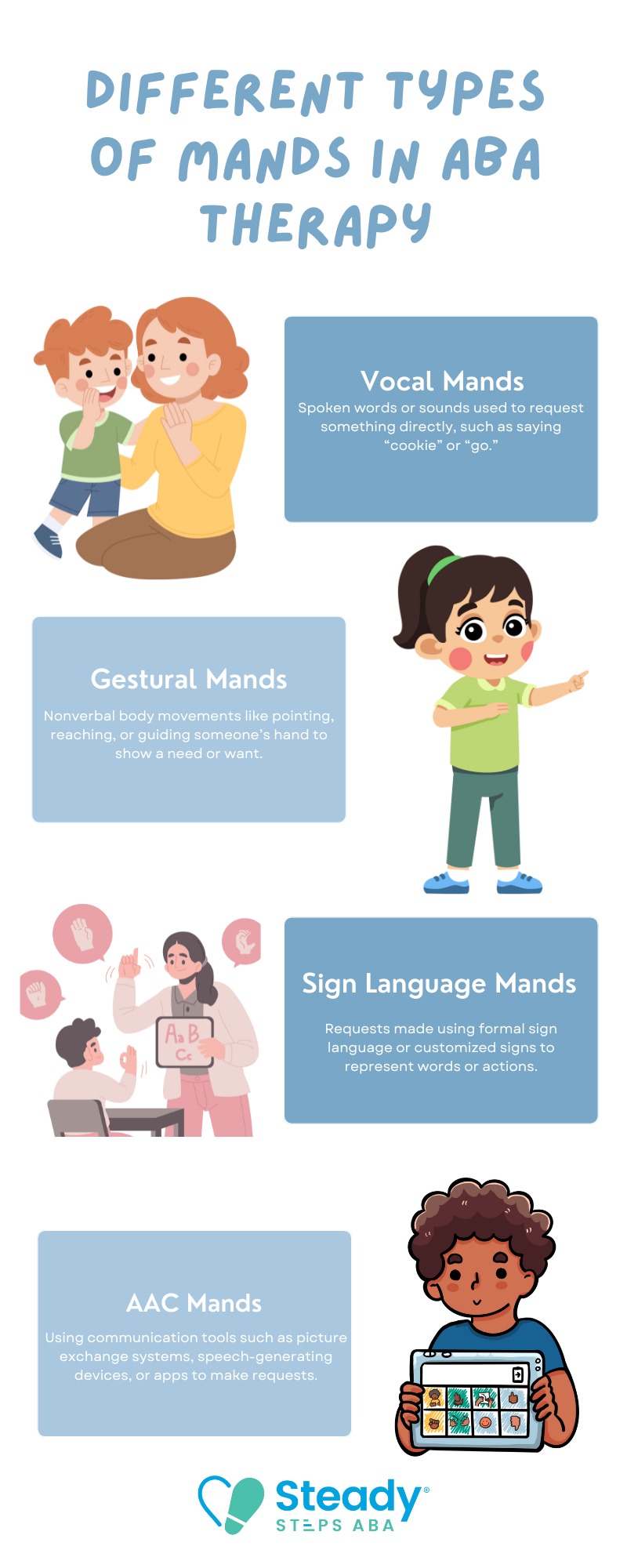Key Points:
- Mands in autism refer to requests or communication acts used to ask for needs and wants, foundational for effective interaction.
- Teaching manding skills helps autistic individuals express themselves and reduce frustration.
- Applied Behavior Analysis (ABA) therapy often focuses on developing mands to improve communication and independence.
Communication challenges are a core feature of autism spectrum disorder (ASD), with up to 70% of autistic children experiencing language developmental delays. Mands in autism play a crucial role in bridging this gap, representing the basic communicative acts where an individual requests or demands something important to them.
Given that communication difficulties are a hallmark of autism, understanding what manding is, how it works, and why it matters is vital for parents, educators, and therapists working to support autistic individuals.
What are Mands in Autism?
Mands in autism are communication acts used by an individual to request or demand something they want or need. This could be asking for food, toys, help, or information. Manding is a form of verbal or nonverbal communication specifically driven by motivation or desire.
In behavior analytic terms, a mand is a type of verbal behavior first defined by B.F. Skinner. It differs from other forms of communication because it is directly controlled by the speaker’s needs or wants, making it one of the most practical and immediately reinforcing forms of communication for autistic individuals. Teaching manding encourages meaningful interaction rather than random or non-functional speech.
Why is Teaching Manding Important in Autism?
Manding is a foundational communication skill that directly addresses many challenges faced by autistic individuals. Without the ability to express needs clearly, frustration and challenging behaviors can increase. When an individual learns to mand effectively, they gain a powerful tool to influence their environment and access desired outcomes.
The benefits of manding include:
1. Reducing Frustration and Challenging Behaviors
When individuals can clearly express their needs, they experience less frustration, which significantly reduces the likelihood of tantrums or aggression caused by communication barriers.
2. Promoting Independence and Building Confidence
Manding empowers individuals to control their environment. This sense of autonomy builds self-confidence and encourages more active participation in daily routines and interactions.
3. Supporting Future Language and Social Skills Development
By mastering mands first, individuals create a foundation for more advanced communication skills like commenting, questioning, and engaging in conversations, which are critical for social interaction.
4. Improving Responsiveness of Caregivers and Educators
When a child mands, adults are more likely to respond appropriately and consistently. This responsiveness builds a positive feedback loop that encourages further communication and learning.
How are Mands Taught in ABA Therapy?
In ABA therapy, mands are taught by identifying highly motivating items or activities and encouraging the individual to request them using appropriate communication. Therapists begin by ensuring the child is motivated, then prompt the desired request—whether verbal, through sign language, or with communication devices—and immediately reinforce the request by providing the item.
Over time, prompts are gradually reduced to build independence. Teaching mands typically starts in natural environments like play or snack times to make learning meaningful and functional. Consistent reinforcement and data tracking help ensure progress and adapt strategies as needed.
Common steps in manding instruction include:
1. Identifying Motivation Through Preference Assessments
Therapists begin by discovering what items or activities the child finds highly motivating. This ensures that the child is more likely to want to communicate to gain access to these preferred stimuli.
2. Using Prompts to Encourage Initial Requests
In early stages, therapists provide verbal, gestural, or physical prompts to help the child produce a mand. These prompts support success and provide a clear model of the expected behavior.
3. Reinforcing Requests to Strengthen Communication
Once the child attempts or completes a mand, the therapist immediately delivers the requested item or activity. This positive reinforcement makes it more likely the child will repeat the behavior in the future.
4. Fading Prompts to Build Independent Manding
As the child becomes more familiar with the process, prompts are gradually reduced. This teaches the child to request independently without needing constant guidance or support.
5. Promoting Generalization Across Settings and People
To ensure communication is meaningful, therapists teach mands in various environments and with different communication partners. This helps the child apply their skills across real-life situations.
This process ensures that manding is functional and meaningful across real-life situations.
What are Different Types of Mands?
Mands can take many forms beyond spoken language, depending on an individual’s abilities and needs. Understanding these variations helps caregivers and therapists support effective, meaningful communication in any setting.
Examples include:

Recognizing and supporting all these forms expands opportunities for successful communication.
How Can Parents Support Manding Development at Home?
Parents can support manding development at home by creating frequent opportunities for their child to request desired items or actions throughout the day. This includes withholding preferred items briefly to encourage the child to ask for them, modeling correct communication, and reinforcing all attempts to mand appropriately.
Using everyday routines like meals, playtime, or dressing as natural teaching moments makes manding more meaningful and consistent. Parents can also collaborate with their child’s ABA therapist to use the same prompting and reinforcement strategies, helping ensure consistency and faster progress. This coordinated approach is especially important when applying structured techniques effectively—just like in Discrete Trial Training for Autism: When and How to Use It Right.
What Challenges Can Arise When Teaching Mands?
While teaching mands can significantly improve communication, the process isn’t without its hurdles. Each child has unique needs and learning styles, and several factors can influence how quickly and effectively they learn to mand. Recognizing these challenges allows caregivers and professionals to respond with patience and appropriate strategies.
1. Limited Motivation or Reinforcers
If a child doesn’t have clear preferences or isn’t motivated by available items, it becomes difficult to encourage them to mand. Identifying strong reinforcers is essential for successful instruction.
2. Inconsistent Prompting and Reinforcement
When prompts or rewards are not used consistently, children may become confused or lose interest in manding. Caregivers and therapists must coordinate closely to maintain consistency across settings.
3. Over-Prompting Without Fading
Relying too heavily on prompts without gradually reducing them can lead to prompt dependency, where the child waits for cues rather than initiating communication independently.
4. Difficulty Generalizing Mands
A child may learn to mand in one setting or with one person, but struggle to apply the skill elsewhere. Teaching across multiple environments and communication partners helps with generalization.
5. Communication Barriers Due to Skill Level
Children with limited verbal or motor skills may need alternative communication methods like AAC or sign language, which can require extra time and training to implement effectively.
What are Some Examples of Mands in Everyday Life?
Mands are everywhere in daily routines—they’re the requests we all make to get our needs met. For autistic children, learning to mand in everyday situations helps make communication more meaningful and functional. These real-life examples show how mands naturally fit into daily life and why they’re essential for independence and social connection:
Asking for Food or Drink
Saying “juice,” pointing to a snack, or using a picture card to request a favorite food are common mands during meals or snack time.
Requesting Help with Tasks
Children might ask for assistance by saying “help,” handing over a toy they can’t open, or leading a caregiver to what they need.
Gaining Access to Favorite Toys or Activities
Mands often involve asking for a preferred toy, activity, or game, either vocally or using signs or AAC tools to make the request.
Requesting a Break or Escape from Tasks
Saying “break,” signing “finished,” or using a button to indicate they need to stop an activity is a mand aimed at escaping discomfort or overload.
Seeking Social Attention
Requests like saying “watch me,” “come here,” or tapping someone’s arm to get attention are also considered mands, especially when they serve a social function.
Support Your Child’s Growth with ABA Therapy
Understanding and developing mands in autism is vital for fostering meaningful communication and independence. At Steady Steps ABA, we provide individualized ABA therapy in Maryland focused on teaching functional communication skills like manding.
Our team partners with families to create tailored programs that motivate communication, reduce frustration, and support overall language development. With compassionate care and evidence-based methods, Steady Steps ABA helps your loved one take confident steps toward greater independence and connection.
Reach out to us to learn how our ABA therapy can support your family’s communication goals in Maryland.






